Search results for: 'mit'
-
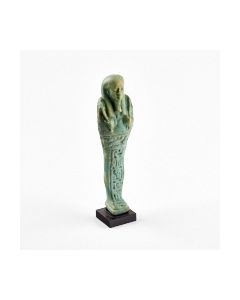 Egyptian funerary figurine of General Semataui
Egyptian funerary figurine of General SematauiVery well preserved ushebti from the Late Period of ancient Egypt. An expertise from 2015 comes with this object. From an old British collection.
Price: on request Egyptian ushabti from the Third Intermediate Period
Egyptian ushabti from the Third Intermediate PeriodFunerary statuette of faience with black paint. The opposed hands might indicate Tanis as origin. Third Intermediate Period of Ancient Egypt.
Price: on request Egyptian shabti
Egyptian shabtiFunerary statuette of faience. The opposed hands might indicate Tanis as origin. Third Intermediate Period of Ancient Egypt.
Price: on request Scarab with cartouche
Scarab with cartoucheAmulet from the Late Period. The stamp is in great condition. This scarab is described in the catalogue of Irène Gautier-Vodoz.
Price: on request Ägyptische Totenfigur aus der 30. Dynastie
Ägyptische Totenfigur aus der 30. DynastieUschebti aus mintgrüner Fayence. Typischer Bart und dreigeteilte Perrücke. Die Totenfigur datiert in ihrer einfachen Form aus der Spätzeit des Alten Ägyptens.
Price: on request Ägyptischer Uschepti, intensive Türkisfarbe
Ägyptischer Uschepti, intensive TürkisfarbeÄgyptische Totenfigur aus der Spätzeit. Besonders intensive, türkisschimmernde Fayence. 113 mm hoch.
Price: on request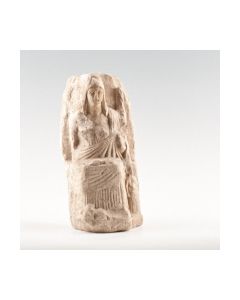 Stone statue of a seated Isis
Stone statue of a seated IsisVery fine condition, from an important London collection
Price: on request Scarab with magic formula
Scarab with magic formulaThe stamp shows the anra formula in a cartouche. The amulet should thus serve a magic or ritual purpose for its owner.
Price: on request Scarab with protective formula
Scarab with protective formulaAmulet for protection. Stilized lotus flowers on the upper side. Magic formula on the lower side. This scarab is described in the catalogue of Irène Gautier-Vodoz.
Price: on request Cowroid with decorated body
Cowroid with decorated bodyThe cowroid has an interesting decoration across the upper surface. The lower surface is inscribed with hieroglyphs. This cowroid is discussed in the catalogue of Gautier-Vodoz.
Price: on request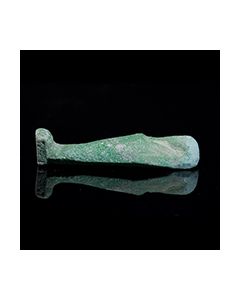 Uschebti aus der Ptolomäerzeit
Uschebti aus der PtolomäerzeitGrüne Fayence, intensive Farbe der Glasur, sehr schöne Züge. Vollständig intakt, nicht restauriert. Ptolomäerzeit, 4.- 3. Jh. v. Chr.
Price: on request Ägyptisches Skarabäus Siegel
Ägyptisches Skarabäus Siegel18. bis 26. Dynastie, 13mm lang. Hieroglyphische Abbildung von Ibisvogel und Rascheibe.
Price: on request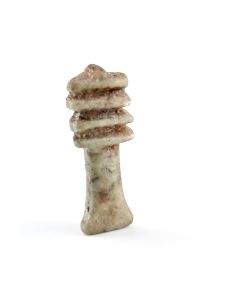 Djed-Pfeiler als Amulett
Djed-Pfeiler als AmulettÄgyptische Spätzeit, 26. bis 30. Dynastie. Mintgrüne Fayence. Der Djed-Pfeiler steht für Dauer und Beständigkeit und war im Alten Ägypten als Amulett sehr beliebt.
Price: on request Uschebti, ägyptische Totenfigur
Uschebti, ägyptische TotenfigurSchöne mintgrüne Fayence, erkennbare Gesichtszüge. Höhe 85mm. 26. - 30. Dynastie, Spätzeit.
Price: on request Scarab with breath of life
Scarab with breath of lifeThe Ankh on the bottom side of this ancient egyptian scarab symbolized life or afterlife. The symbol is framed by volutes.
Price: on request Small scarab amulet with Isis hieroglyphs
Small scarab amulet with Isis hieroglyphsThe tiny amulet dates to the New Kingdom. It bears the glyphs for the goddess Isis. This scarab is described in the catalogue of Irène Gautier-Vodoz.
Price: on request Egyptian sarcophagus mask
Egyptian sarcophagus maskImpressive wood relief of an idealized face. Polychrome paint. The mask was part of a sarcophagus lid from the Late Period of Ancient Egypt.
Price: on request Cowroid with magical anra formula
Cowroid with magical anra formulaThe bottom side hieroglyphs of the anra type are to be interpreted as magical formula. The amulet dates to the Second Intermediate Period of ancient Egpyt.
Price: on request Egyptian faience ring showing Bes and Taweret
Egyptian faience ring showing Bes and TaweretThe finger ring with its scene on the plate must have served a protective function for an expectant mother. New Kingdom, approx. 1550 to 1070 BC.
Price: on request Egyptian amulet of Anubis
Egyptian amulet of AnubisThe amulet from the Late Period of Ancient Egypt was supposed to protect the dead on their way to the afterlife. From a British private museum.
Price: on request Egyptian amulet of Anubis
Egyptian amulet of AnubisThe amulet from the Late Period of Ancient Egypt was supposed to protect the dead on their way to the afterlife. From a British private museum.
Price: on request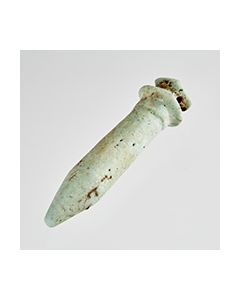 Egyptian papyrus scepter amulet
Egyptian papyrus scepter amuletPapyrus scepter made of faience. Late Period of Ancient Egypt. It symbolizes prosperity and youth. From the stock of a british private museum.
Price: on request Egyptian tomb relief from Memphis
Egyptian tomb relief from MemphisThe flat relief shows an offering scene and above a hieroglyphic text describing the deceased Ptah-nefer, the priest and the offerings. A translation has been made by the renowned Egyptologist professor Kurth. The work of art dates to the 26th dynasty. It is adopting the style of the Old Kingdom.
Price: on request Uschepti der 21. Dynastie
Uschepti der 21. DynastieÄgyptische Totenfigur der 3. Zwischenzeit. Schöne türkise Fayence. Aufgemalte Hieroglyphen, Stirnband und Korb. Eindrucksvoller Uschepti.
Price: on request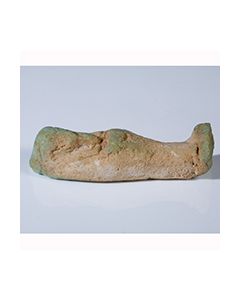 Ushebti, Ptolomäerzeit
Ushebti, PtolomäerzeitSehr gute Erhaltung. Intensive Farbgebung, grün-weiße Fayence. Höhe 4,5 cm, 4 - 3. Jh. v. Chr., ptolomäische Epoche.
Price: on request Scarab with sphinx
Scarab with sphinxThe stamp depicts a sphinx with pharaoh headcloth walking towards the Ankh symbol of life. The amulet should exert a protective function on the one carrying or owning it.
Price: on request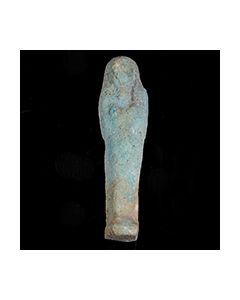 Uschebti aus der Ptolomäerzeit
Uschebti aus der PtolomäerzeitWeiß-grüne Fayence, Höhe ca. 7,4 cm, 4. Jh. v. Chr - 3. Jh. v. Chr., Ptolomäerzeit.Sehr gute Erhaltung, ausgearbeitete Gesichtszüge, vollständig intakt.
Price: on request Egyptian papyrus scepter amulet
Egyptian papyrus scepter amuletAmulet in the shape of a papyrus scepter. Late Period of Ancient Egypt. It symbolizes prosperity and youth. From the stock of a british private museum.
Price: on request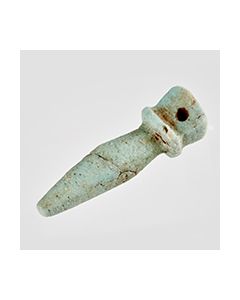 Egyptian papyrus scepter amulet
Egyptian papyrus scepter amuletAmulet in the shape of a papyrus scepter. Late Period of Ancient Egypt. It symbolizes prosperity and youth. From the stock of a british private museum.
Price: on request Tonstatuette des Harpokrates aus dem Fayum
Tonstatuette des Harpokrates aus dem FayumKurze, dicke Locken, darauf Blumenkranz, darüber Doppelkrone. Hohe Stirn, knollige flache Nase, tief sitzende Augen. Plastisch gearbeitete Gewandfalten.
Price: on request Roman-Egyptian portrait of a young woman
Roman-Egyptian portrait of a young womanExcellent condition, original stucco and painting partially preserved. From an old collection of a Frech engineer. With Art Loss certificate
Price: on request Serapis marble bust from Joachim Menant collection
Serapis marble bust from Joachim Menant collectionFamous egyptologist who excavated in Alexandria in the 19th century. Acquired in Egypt during this time, since then and until 2016 in the Menant family collection. With Art Loss certificate.
Price: on request Scarab with two cartouches of Thutmose III.
Scarab with two cartouches of Thutmose III.Interesting amulet from the New Kingdom or a later period made in archaic style. This scarab is described in the catalogue of Irène Gautier-Vodoz.
Price: on request Scarab with hieroglyphs arranged in a pattern
Scarab with hieroglyphs arranged in a patternThe lower side is skillfully decorated with hieroglyphs forming a geometric pattern. This scarab is described in the catalogue of Irène Gautier-Vodoz.
Price: on request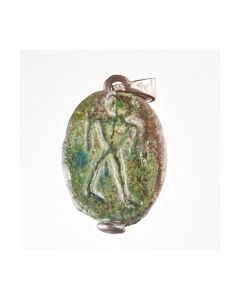 Scarab with standing figure
Scarab with standing figureThe scarab amulet dates to the Late Period. The lower side shows a stading figure, possibly the goddess Neith.
Price: on request Scarab with lion
Scarab with lionThe scene shows a walking lion. It is framed by an oval cord. This scarab is described in the catalogue of Irène Gautier-Vodoz.
Price: on request

